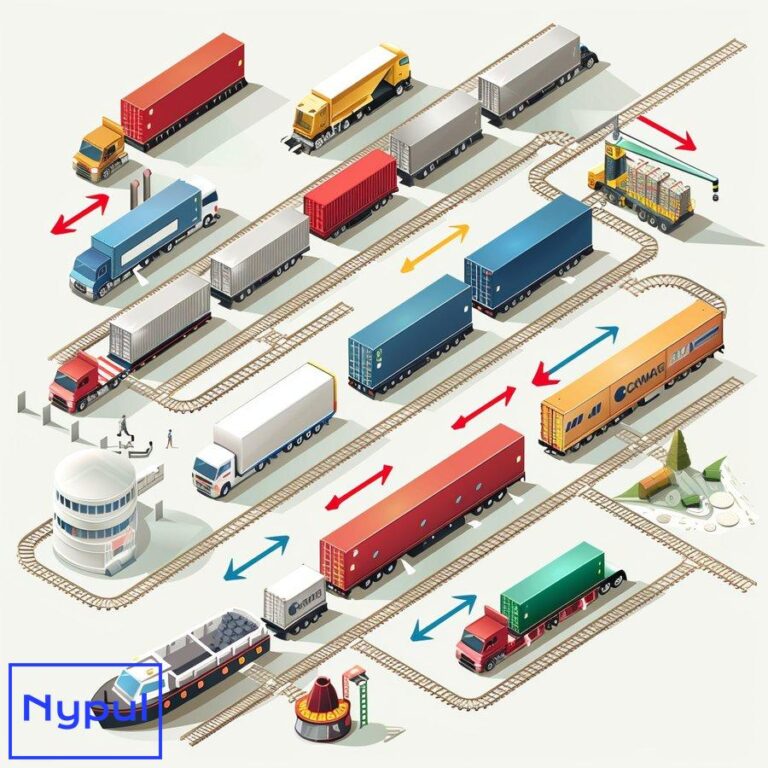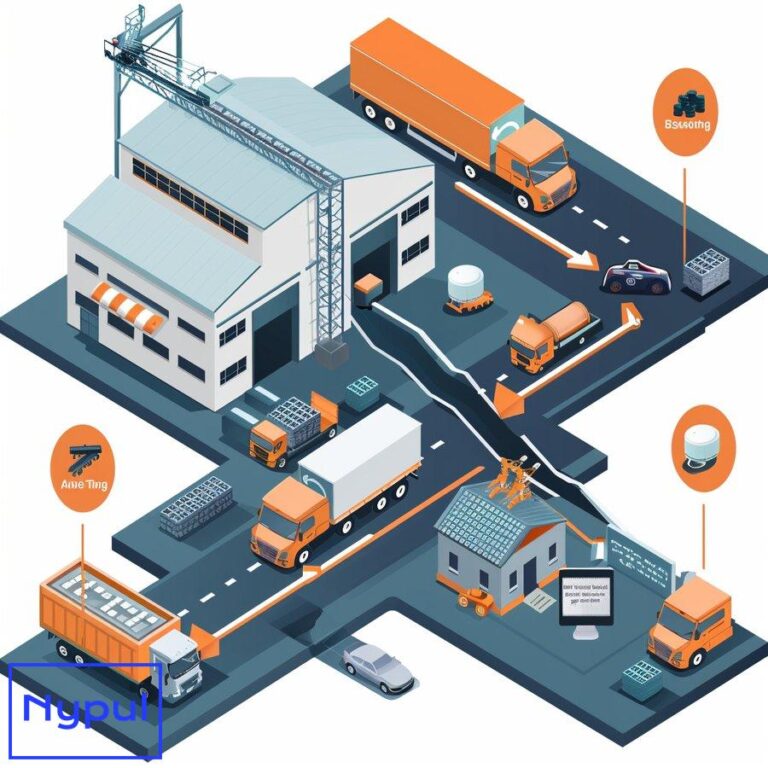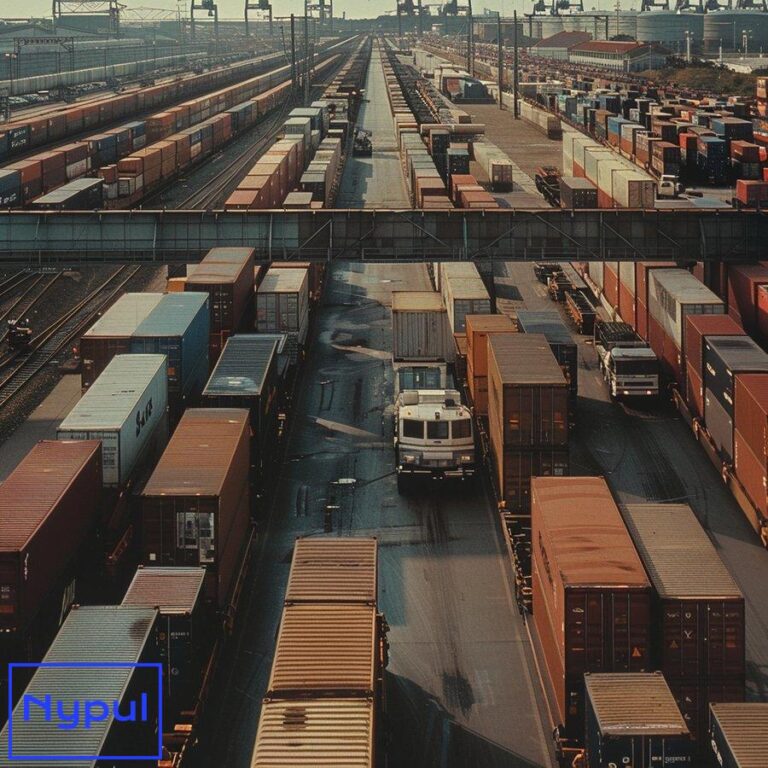What Are the KPIs for Transport Operations
What are KPIs in Transport Operations?

Key Performance Indicators (KPIs) in transport operations are quantifiable measurements that evaluate the success and efficiency of various aspects of transportation processes. These metrics provide valuable insights into the performance of a company’s logistics and supply chain management.

KPIs in transport operations serve several critical functions:
Measuring Performance: KPIs allow companies to objectively assess their transportation processes’ effectiveness and efficiency. By tracking specific metrics, organizations can determine whether they are meeting their goals and identify areas for improvement.
Identifying Trends: Regularly monitoring KPIs helps identify trends and patterns in transport operations over time. This information can be used to make data-driven decisions, anticipate future challenges, and capitalize on opportunities.
Benchmarking: KPIs enable companies to compare their performance against industry standards and competitors. This benchmarking helps organizations understand their relative position in the market and set realistic targets for improvement.
Driving Continuous Improvement: By setting targets for each KPI and regularly reviewing progress, companies can foster a culture of continuous improvement. KPIs help identify bottlenecks, inefficiencies, and areas requiring attention, allowing organizations to take corrective action and optimize their transport operations.
Some common examples of KPIs in transport operations include:
| KPI | Description |
|---|---|
| On-Time Delivery | Percentage of deliveries made within the promised timeframe |
| Transportation Costs | Total cost of transportation as a percentage of sales or per shipment |
| Fleet Utilization | Percentage of time vehicles are in use or revenue-generating |
| Fuel Efficiency | Average fuel consumption per mile or kilometer |
| Damage/Loss Percentage | Percentage of shipments that experience damage or loss |
By carefully selecting and monitoring the most relevant KPIs for their specific operations, transportation companies can gain valuable insights, make informed decisions, and continuously improve their performance.
Which Key Performance Areas Should Transport KPIs Focus On?
To effectively measure and optimize transport operations, KPIs should focus on several key performance areas. These areas represent the most critical aspects of transportation that directly impact a company’s success, efficiency, and customer satisfaction.
![]()
Cost Management: Transportation costs are a significant expense for most companies. KPIs in this area should track the total cost of transportation, including fuel, maintenance, labor, and other related expenses. By monitoring cost-related KPIs, companies can identify opportunities to reduce expenses and improve profitability.
Example KPIs:
– Transportation Cost as a Percentage of Sales
– Cost per Mile/Kilometer
– Cost per Shipment
Service Quality: Delivering goods on time and in perfect condition is essential for customer satisfaction and loyalty. KPIs in this area should measure the reliability, timeliness, and accuracy of transportation services.
Example KPIs:
– On-Time Delivery Rate
– Order Accuracy Rate
– Customer Satisfaction Score
Asset Utilization: Maximizing the use of transportation assets, such as vehicles and equipment, is crucial for efficiency and cost-effectiveness. KPIs in this area should track how well a company utilizes its assets and identify opportunities to optimize their use.
Example KPIs:
– Fleet Utilization Rate
– Average Load Factor
– Empty Miles/Kilometers Percentage
Safety and Compliance: Ensuring the safety of employees, cargo, and the public is a top priority for transportation companies. KPIs in this area should monitor compliance with safety regulations, track accidents and incidents, and measure the effectiveness of safety training and procedures.
Example KPIs:
– Accident Frequency Rate
– Driver Safety Score
– Compliance Audit Score
Sustainability: As environmental concerns grow, companies are increasingly focused on reducing their carbon footprint and promoting sustainable practices. KPIs in this area should track the environmental impact of transportation operations and measure progress toward sustainability goals.
Example KPIs:
– Carbon Emissions per Mile/Kilometer
– Percentage of Alternative Fuel Vehicles
– Waste Reduction Rate
By focusing on these key performance areas and selecting relevant KPIs for each, transportation companies can gain a comprehensive view of their operations, identify areas for improvement, and make data-driven decisions to optimize their performance.
What are the Essential KPIs for Measuring Transport Performance?
To effectively measure transport performance, companies should track a set of essential KPIs that cover the most critical aspects of their operations. These KPIs provide a comprehensive view of the efficiency, effectiveness, and quality of transportation services.

On-Time Delivery Rate (OTDR): OTDR measures the percentage of shipments delivered within the promised timeframe. This KPI is crucial for assessing service reliability and customer satisfaction.
Formula: (Number of On-Time Deliveries ÷ Total Number of Deliveries) × 100
Transportation Cost as a Percentage of Sales (TCPS): TCPS measures the total cost of transportation as a proportion of a company’s sales revenue. This KPI helps evaluate the efficiency of transportation operations and their impact on profitability.
Formula: (Total Transportation Costs ÷ Total Sales Revenue) × 100
Average Fuel Consumption: This KPI tracks the average amount of fuel consumed per mile or kilometer driven. Monitoring fuel consumption helps companies optimize their fuel efficiency, reduce costs, and minimize their environmental impact.
Formula: Total Fuel Consumed ÷ Total Miles/Kilometers Driven
Damage/Loss Percentage: This KPI measures the percentage of shipments that experience damage or loss during transportation. Tracking this metric helps companies identify areas for improvement in cargo handling and packaging.
Formula: (Number of Damaged/Lost Shipments ÷ Total Number of Shipments) × 100
Fleet Utilization Rate: This KPI measures the percentage of time that vehicles are in use or revenue-generating. Optimizing fleet utilization helps companies maximize their assets’ productivity and reduce idle time.
Formula: (Total Hours of Vehicle Use ÷ Total Available Hours) × 100
Order Accuracy Rate: This KPI tracks the percentage of orders that are accurately fulfilled, including the correct items, quantities, and specifications. Maintaining a high order accuracy rate is essential for customer satisfaction and reducing the costs associated with returns and corrections.
Formula: (Number of Accurate Orders ÷ Total Number of Orders) × 100
Driver Safety Score: This KPI assesses the safety performance of individual drivers based on factors such as accidents, traffic violations, and compliance with safety procedures. Monitoring driver safety helps companies promote a culture of safety and reduce the risk of accidents and liabilities.
Formula: Weighted average of safety metrics (e.g., accidents, violations, training completion)
By tracking these essential KPIs, transportation companies can gain valuable insights into their performance, identify areas for improvement, and make data-driven decisions to optimize their operations. Regular monitoring and analysis of these metrics will help companies stay competitive, reduce costs, and provide high-quality services to their customers.
How Can You Implement KPIs in Your Transport Operations?
Implementing KPIs in transport operations requires a structured approach to ensure that the right metrics are selected, tracked, and acted upon. Here are the key steps to successfully implement KPIs in your transportation company:
Define Your Goals and Objectives: Start by clearly defining your company’s overall goals and objectives for transport operations. These may include improving efficiency, reducing costs, enhancing customer satisfaction, or promoting sustainability. Your KPIs should align with these goals and help you measure progress toward achieving them.

Select Relevant KPIs: Based on your goals and objectives, identify the most relevant KPIs for your transport operations. Consider the key performance areas discussed earlier, such as cost management, service quality, asset utilization, safety and compliance, and sustainability. Choose KPIs that are specific, measurable, achievable, relevant, and time-bound (SMART).
Establish Baseline Measurements: Before setting targets for your KPIs, establish baseline measurements to understand your current performance levels. Collect data on your selected KPIs for a specific period (e.g., the previous quarter or year) to create a benchmark against which future performance can be compared.
Set Targets: Based on your baseline measurements and industry benchmarks, set realistic yet challenging targets for each KPI. These targets should be aligned with your overall goals and objectives and should be communicated clearly to all relevant stakeholders.
Assign Responsibilities: Assign specific roles and responsibilities for tracking, reporting, and acting upon each KPI. Ensure that everyone involved understands their role in the KPI implementation process and has the necessary resources and support to fulfill their responsibilities.
Implement Data Collection and Reporting Systems: Establish reliable data collection and reporting systems to track your KPIs regularly. This may involve using transportation management software, telematics systems, or other tools to automate data collection and analysis. Ensure that data is accurate, timely, and accessible to all relevant stakeholders.
Regularly Review and Analyze KPIs: Schedule regular meetings to review and analyze your KPIs with key stakeholders. Use these meetings to discuss performance trends, identify areas for improvement, and make data-driven decisions to optimize your transport operations.
Communicate Results and Celebrate Success: Regularly communicate KPI results to all employees and stakeholders to foster a culture of transparency and accountability. Celebrate successes and recognize individuals or teams who have contributed to improving KPI performance.
Continuously Refine and Adapt: As your transport operations evolve, continuously refine and adapt your KPIs to ensure they remain relevant and effective. Regularly review your KPI selection, targets, and implementation processes to identify opportunities for improvement and ensure ongoing alignment with your goals and objectives.
By following these steps, you can effectively implement KPIs in your transport operations, driving continuous improvement and optimizing performance across your organization.
What Challenges Might You Face When Measuring Transport KPIs?

While measuring transport KPIs is essential for optimizing performance and driving continuous improvement, companies may face several challenges during the implementation and monitoring process. Recognizing and addressing these challenges is crucial for ensuring the success of your KPI program.

Data Quality and Consistency: One of the most common challenges in measuring transport KPIs is ensuring the quality and consistency of data. Inaccurate, incomplete, or inconsistent data can lead to misleading KPI results and poor decision-making. To overcome this challenge, companies must establish robust data collection and validation processes, ensure that all relevant stakeholders are trained on data entry procedures, and regularly audit data quality.
Integration of Data from Multiple Sources: Transport operations often involve multiple systems and data sources, such as transportation management software, telematics systems, and manual records. Integrating data from these various sources can be challenging, leading to data silos and inconsistencies. To address this challenge, companies should invest in data integration tools and establish standardized data formats and protocols across all systems.
Resistance to Change: Implementing a KPI program may face resistance from employees who are accustomed to traditional ways of working and may view KPIs as an additional burden or a threat to their autonomy. To overcome this challenge, companies must communicate the benefits of KPIs clearly, involve employees in the KPI selection and implementation process, and provide training and support to help them adapt to the new system.
Setting Appropriate Targets: Setting targets that are too low or too high can undermine the effectiveness of your KPI program. Targets that are too low may not drive meaningful improvement, while targets that are too high may demotivate employees and lead to burnout. To address this challenge, companies should set targets based on a combination of historical performance, industry benchmarks, and strategic objectives, and regularly review and adjust targets as needed.
Balancing Short-Term and Long-Term Goals: Transport KPIs often focus on short-term performance, such as on-time delivery rates or cost per shipment. However, companies must also consider long-term goals, such as sustainability, innovation, and employee development. Balancing short-term and long-term goals can be challenging, but it is essential for ensuring the long-term success of your organization. To address this challenge, companies should select a mix of KPIs that cover both short-term and long-term objectives and ensure that incentives and rewards are aligned with both types of goals.
Ensuring Actionability: Measuring KPIs is only valuable if the insights gained are used to drive action and improvement. Companies may struggle to translate KPI results into actionable insights and initiatives, leading to a lack of progress and frustration among employees. To overcome this challenge, companies should establish clear processes for reviewing KPI results, identifying areas for improvement, and implementing corrective actions. Regular communication and collaboration among stakeholders are also essential for ensuring that insights are shared and acted upon.
By recognizing and proactively addressing these challenges, companies can ensure that their transport KPI program delivers meaningful results and drives continuous improvement across their operations.
How Can Technology Enhance KPI Tracking in Transport?
Technology plays a crucial role in enhancing KPI tracking in transport operations. By leveraging various digital tools and systems, companies can automate data collection, improve data accuracy, and gain real-time insights into their performance. Here are some key ways in which technology can enhance KPI tracking in transport:
Transportation Management Systems (TMS): A TMS is a software platform that helps companies plan, execute, and optimize their transportation operations. TMS solutions often include built-in KPI tracking capabilities, allowing companies to monitor key metrics such as on-time delivery rates, transportation costs, and carrier performance in real-time. By integrating data from multiple sources and providing customizable dashboards and reports, a TMS can help companies gain a comprehensive view of their transport performance and identify areas for improvement.
Telematics and GPS Tracking: Telematics systems use GPS technology to track the location, speed, and performance of vehicles in real-time. By collecting data on factors such as fuel consumption, idle time, and driver behavior, telematics systems can provide valuable insights into fleet utilization, fuel efficiency, and safety performance. This data can be used to calculate KPIs such as average fuel consumption, fleet utilization rate, and driver safety scores, enabling companies to optimize their fleet operations and reduce costs.
Internet of Things (IoT) Sensors: IoT sensors can be used to track the condition and status of cargo in real-time, providing valuable data for KPIs related to damage/loss prevention and customer satisfaction. For example, temperature sensors can monitor the condition of temperature-sensitive goods, while shock sensors can detect potential damage during transport. By integrating this data with other systems, such as a TMS or warehouse management system (WMS), companies can gain end-to-end visibility into their supply chain and proactively address potential issues.
Business Intelligence (BI) and Analytics Tools: BI and analytics tools can help companies turn raw transportation data into actionable insights for KPI improvement. By integrating data from multiple sources, such as TMS, telematics, and financial systems, BI tools can provide customizable dashboards, reports, and data visualizations that highlight key trends, anomalies, and opportunities for improvement. Advanced analytics techniques, such as predictive modeling and machine learning, can also be used to identify patterns and forecast future performance, enabling companies to make proactive, data-driven decisions.
Mobile Apps and Devices: Mobile apps and devices can help companies collect and access KPI data in real-time, even when employees are on the go. For example, drivers can use mobile apps to record delivery status, capture proof of delivery, and report any issues or delays. Managers can use mobile dashboards to monitor KPIs and receive alerts when performance deviates from targets. By enabling real-time data collection and communication, mobile technologies can help companies respond quickly to issues and opportunities, improving overall transport performance.
By leveraging these technologies, companies can enhance their KPI tracking capabilities and gain a more comprehensive, real-time view of their transport operations. However, it is important to ensure that technology investments are aligned with business goals, that data quality and security are maintained, and that employees are properly trained to use these tools effectively. With the right technology strategy in place, companies can drive significant improvements in transport performance and competitiveness.
What Can We Learn from Successful KPI Implementations in Transport?

Studying successful KPI implementations in transport operations can provide valuable insights and best practices for companies looking to optimize their own performance measurement systems. By examining case studies and real-world examples, companies can learn from the experiences of others and adapt proven strategies to their own unique contexts. Here are some key lessons that can be learned from successful KPI implementations in transport:
Align KPIs with Business Strategy: Successful KPI implementations are closely aligned with a company’s overall business strategy and objectives. By selecting KPIs that directly support strategic goals, such as cost reduction, service improvement, or sustainability, companies can ensure that their performance measurement system is driving meaningful progress. For example, a company that prioritizes customer satisfaction may focus on KPIs such as on-time delivery rate and order accuracy, while a company that emphasizes sustainability may track metrics related to carbon emissions and waste reduction.
Involve Stakeholders in KPI Selection and Implementation: Successful KPI implementations involve a wide range of stakeholders, including executives, managers, front-line employees, and external partners. By engaging these stakeholders in the KPI selection and implementation process, companies can ensure that the chosen metrics are relevant, actionable, and widely accepted. For example, involving drivers in the selection of safety-related KPIs can help ensure that the metrics are meaningful and that drivers are motivated to improve their performance.
Use a Balanced Scorecard Approach: Successful KPI implementations often use a balanced scorecard approach, which measures performance across multiple dimensions, such as financial, customer, internal process, and learning and growth. By using a balanced set of KPIs, companies can ensure that they are not over-emphasizing one area of performance at the expense of others. For example, a company that focuses solely on cost reduction may inadvertently compromise service quality or employee satisfaction, leading to long-term problems.
LeverageLeverage Data Analytics for Insights**: Successful KPI implementations utilize data analytics to turn raw data into actionable insights. Companies that invest in analytics tools can identify trends, anomalies, and opportunities for improvement more effectively. For instance, a logistics company might analyze historical delivery data to predict peak demand periods, allowing them to allocate resources more efficiently and improve on-time delivery rates.
Establish Clear Communication Channels: Effective communication is essential for successful KPI implementation. Companies that establish clear communication channels for sharing KPI results and insights can foster a culture of accountability and continuous improvement. Regular meetings, dashboards, and reports can help keep all stakeholders informed about performance trends and areas needing attention. For example, a company might hold monthly performance review meetings to discuss KPI outcomes and collaboratively develop action plans for improvement.
Provide Training and Support: Successful KPI implementations prioritize employee training and support to ensure that all team members understand the importance of KPIs and how to use them effectively. Companies that invest in training programs can empower their employees to take ownership of their performance metrics and contribute to continuous improvement efforts. For example, a transportation company might offer workshops on data entry best practices and KPI interpretation to help employees better understand their roles in achieving performance goals.
Celebrate Achievements and Learn from Failures: Recognizing and celebrating achievements related to KPI performance can motivate employees and reinforce a culture of continuous improvement. Companies that acknowledge individual and team contributions to KPI success can foster a sense of ownership and accountability. Conversely, organizations should also learn from failures and setbacks, analyzing the root causes of underperformance and developing strategies to address them. For instance, if a company experiences a decline in on-time delivery rates, it should conduct a thorough analysis to identify contributing factors and implement corrective actions.
Continuously Review and Adapt KPIs: Successful KPI implementations recognize that performance measurement is an ongoing process. Companies that regularly review and adapt their KPIs to reflect changing business conditions, market trends, and strategic objectives can maintain their relevance and effectiveness. For example, a transportation company may need to adjust its KPIs to account for new regulations, customer demands, or technological advancements.
By learning from these successful KPI implementations, transportation companies can develop and refine their own performance measurement systems, driving continuous improvement and optimizing their operations for long-term success. Emphasizing alignment with business strategy, stakeholder involvement, data analytics, communication, training, recognition, and adaptability will help organizations create a robust KPI framework that supports their goals and enhances overall performance.






